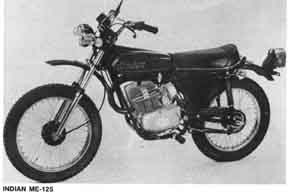Newman Indian ME125
The Indian 1973-1974 ME125 was an Enduro class dirt bike, designed to be street legal and worthy of the dirt track.
- 123CC Two-Stroke single-cyclinder Motori Minarelli Engine
- Distinctive "sunburst" top-end fin design
- Bore and stroke: 55m x 52mm
- Compression ratio: 9.3:1
- 25mm DellOrto carburetor
- Kick start (don't let the lights-only battery fool you!)
- Five-speed
- Solo seat with folding footpegs
- Headlight, high beam, front and rear blinkers, brake light
- 50" wheel base
- 187 lb. dry weight
- Top speed 75 MPH
- 6v electrical system, Zener diode regulated.
- Original Price: $729
Identification[edit | edit source]
| Paint Color | Model Year |
|---|---|
| Blue | 1973 |
| Silver | 1974 |
Parts Manuals[edit | edit source]
Parts Interchange[edit | edit source]
Engine[edit | edit source]
The Fantic Chopper 125 - possibly also the Fantic RC125 used the same 125/5 engine as the Indian ME125.
Turn Signals[edit | edit source]
Any single-wire turn signal (chassis ground, hot wire) with a male M8x1.25 metric threaded connector should fit the bill.
Fuel Petcock[edit | edit source]
The zinc fuel petcock tends to crumble into dust after 25 years or so, and will need to be replaced.
You can replace it with a metric M16x1 female thread petcock, available from many Italian and German dirt bike suppliers. Unfortunately, most of them will not ship to the USA. As of this writing, http://www.trebes-motoparts.de carries several compatible Bing M16x1 petcocks, and will ship to the US and Canada.
Use Trebes-Motoparts part number 000.009.437 for a Bing M16x1 petcock with a built in fuel filter.
Del Orto Carb Adjustment[edit | edit source]
The idle screw impacts starting the engine from a cold start, and is a very tricky adjustment. If you get it wrong, your engine will not start at all.
It can be reset by turning it all the way in, then unscrewing it two and a half turns.
Any further adjustment should be in 1/8 turn increments. It's an incredibly sensitive adjustment screw.
Oil Change[edit | edit source]
Many 1973/1974 models have an unfortunate design flaw that has lead to the death of many a kickstart spring. There are two bolts on the underside of the engine that look like they are the oil drain plug.
The bolt immediately under the kickstart lever is the kickstart stop bolt - this is what keeps the kickstart from completely unwinding. It is also the only under-engine bolt visible if the skid plate is installed, as the 'oil drain hole' in the skid plate is in the wrong place, and the skid plate covers the real oil drain.
DO NOT REMOVE THE KICKSTART STOP BOLT: You will have to take the right side engine cover off to fix the kickstart if you do!
Remove the skid plate, and you will find the real oil drain plug in the rear-middle of the engine. Unbolt, and drain.
(While you're waiting for the oil to drain, now might be a good time to make a hole in the skid plate for the real plug.)
Refill the engine with 48oz of SAE 30 Weight Motorcyle wet-clutch compatible oil, and you should be good to go. DO NOT USE DETERGENT MOTOR OILS: they will bind up your wet-clutch.
"Breaking" the Clutch Plates[edit | edit source]
If your clutch plates have seized, you can try to unstick them by:
- Setting the keyswitch to "OFF"
- Squeeze the clutch level firmly
- Kick the kickstart a few times
If the clutch is frozen, you should feel some resistance, and hear the engine go blub blub blub a few times. When the clutch plates come free, you will feel almost no resistance on the kickstart, and the engine won't make a sound.
Ignition Switch Settings[edit | edit source]
From the 7 oclock position, onwards:
- 7 oclock - Off
- 8 oclock - On (no lights)
- 9 oclock - On (lights)
- 10 oclock - Park (light on)
